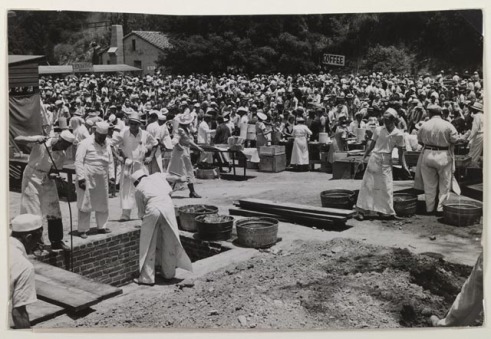America Eats! – Part I
This is going to be a two-part post because I want to just get a few thoughts out there for the moment and then, in the later post, provide you all with useful links and more factual information. I have been intrigued and excited by the America Eats! project ever since I first read about it probably four years ago when I first started getting into food research and culinary history. America Eats! was a WPA sponsored project organized by Katharine Kellock just prior to the second world war. The goal was to send writers around the country to record group meals and food-related public events in “images of a resilient people working to common and joyful purpose in the teeth of the Great Depression.” Most of the writing generated by this project was never published because it was not compiled and edited before the start of WWII, it got lost in the ensuing shuffle, as it were. A few culinary historians and other researchers have used bits and pieces of the writings from the project for research since that time, but it is not even known where all the materials are because many are still housed in local community libraries and archives, though there is also a good deal in the Library of Congress. Over the last several years interested scholars have banded together to try to encourage a return to this work, to try to relocate all of the writing and to utilize this unbelievable resource as a window into the American culinary past. I can tell you that I would love, love, love to be able to do just that.
(An image from the original America Eats! project archives – removing the barbecue beef from the pits at the Los Angeles Sheriff’s Barbecue.)
What I wanted to react to in this post was an article that appeared in a culinary history newsletter that I get called Food History News written by Patricia Willard, a woman who has gone back and looked at a great deal of the America Eats! papers and then followed up by revisiting the sites that these writers recorded their community events at in the 1930s to see whether these sorts of traditions continue today. She has some extremely insightful comments about American food which I hope to be able to explore in more detail in the later post as well, but I want to latch on to one particular point that she made in this short introduction. She writes “Somewhere in my travels, though, I came to realize how accurately Kellock had gauged our cooking. By talking about our food within the context of social engagements, the Federal Writers were able to uncover something very important about our cuisine: it’s not actually the taste of our food, but the use of it that’s been important in our cooking’s development. Even at the most food-centric gatherings, emphasis was less on the dishes than in how they supported the reason for people to meet.”
This statement reminded me of something I know all to well, and I’m sure you do too, that a meal is not special unless it has meaning, and it often gains meaning because of the people that we eat that meal with. Now that doesn’t suggest that every meal will be special if it is consumed with others (afterall America Eats! focused on community-wide social events, not an everyday occurrence, though certainly more frequent in the 1930s than today), but that perhaps we need to think a little bit less about the food itself, to take a step back from analyzing in minute detail the flavors and textures and visual appeal of the foods which are placed in front of us, and to just appreciate the event for what it is, an opportunity to form or reassert relationships with people. Certainly the analysis of food for food’s sake has its place and I do a lot of it myself, it can be a communal activity that draws people together in and of itself, but at its heart I think we should keep in mind that food is mearly the vehicle or the excuse for a gathering, that is the shared experience which is what we all benefit most from in the end, which will last us longer than the last bite of dessert or the last sip of coffee. Even as you embrace your foodie side, focusing more on the ingredients and becoming increasingly interested in new and varied cuisines, presentations, etc., never forget that there is a whole lot more going on beyond the edges of your plate, that though the flavors may take you to distant lands and far away places, the people sitting right next to and across from you are the ones with whom you are sharing the experience of that meal and that is, I would argue, more important than what you’re putting in your mouth.
Explore posts in the same categories: America Eats!, culinary history, Food
Leave a comment